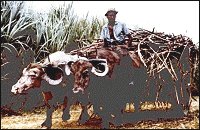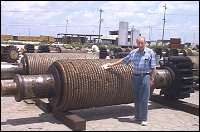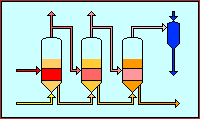Well yesterday was a long drive through the mountains and when I went to bed last night around 11pm I was quite tired but could not get to sleep and was up again at midnight and puttered around till 3am when I finally fell asleep and up at 7.15am as I had an 8am tennis date with Carolyn and the nice friends, Erika and Colin from Victoria…we had 4 good sets and the weather was great…E & C are very good players and we gave them a good game but as yet not able to take a set off them and today I was below par and Carolyn played great but I did enjoy the game and the friendship.
We decided to treat ourselves for breakfast at a really nice restaurant on the main street into town I was ravenous and had the best French toast, eggs and bacon….I then went and had Carolyn's car washed and then home by 1pm…I decided to take it easy I do have just the touch of a sore throat so I did some watering of my plants and cleaning up and read for the afternoon.
I had tickets for a series of small plays at the local theatre tonight and Carolyn decided she also was not feeling 100% so she would stay home so I managed to sell the other ticket and went to the show which was very different and entertaining.
Was home fairly early and having tea and reflecting on the last week it was a wonderful trip we took and those waterfalls were quite magnificent and I shall not forget those swallows dive bombing into that huge cave and of to have seen the surreal gardens of Edward James was such a treat. Carolyn and I both talked about how lucky we are to live where we do with so much diversity only a day’s drive away.
A busy weekend coming along so stay tuned!!!
Remember all those sugar canes truck we told you we ased Carolyn sent me the following!!!!
How Cane Sugar is Made - the Basic Story

Growing the Cane
Sugar cane is a sub-tropical and tropical crop that prefers lots of sun and lots of water - provided that its roots are not waterlogged. It typically takes about 12 months to reach maturity although the time varies widely around the world from as short as six months in Louisiana to 24 months in some places. Where it differs from many crops is that it re-grows from the roots so the plant lasts many cycles [or 'ratoons', a word derived from the Spanish to sprout] before it is worn out.

Harvesting
Sugar cane is harvested by chopping down the stems but leaving the roots so that it re-grows in time for the next crop. Harvest times tend to be during the dry season and the length of the harvest ranges from as little as 2 ½ months up to 11 months. The cane is taken to the factory: often by truck or rail wagon but sometimes on a cart pulled by a bullock or a donkey!

Extraction
The first stage of processing is the extraction of the cane juice. In many factories the cane is crushed in a series of large roller mills: similar to a mangle [wringer] which was used to squeeze the water out of clean washing a century ago. The sweet juice comes gushing out and the cane fibre is carried away for use in the boilers. In other factories a diffuser is used as is described for beet sugar manufacture. Either way the juice is pretty dirty: the soil from the fields, some small fibres and the green extracts from the plant are all mixed in with the sugar.

Evaporation
The factory can clean up the juice quite easily with slaked lime (a relative of chalk) which settles out a lot of the dirt so that it can be sent back to the fields. Once this is done, the juice is thickened up into a syrup by boiling off the water using steam in a process called evaporation. Sometimes the syrup is cleaned up again but more often it just goes on to the crystal-making step without any more cleaning. The evaporation is undertaken in order to improve the energy efficiency of the factory.

Boiling
The syrup is placed into a very large pan for boiling, the last stage. In the pan even more water is boiled off until conditions are right for sugar crystals to grow. You may have done something like this at school but probably not with sugar because it is difficult to get the crystals to grow well. In the factory the workers usually have to throw in some sugar dust to initiate crystal formation. Once the crystals have grown the resulting mixture of crystals and mother liquor is spun in centrifuges to separate the two, rather like washing is spin dried. The crystals are then given a final dry with hot air before being stored ready for despatch.

Storage
The final raw sugar forms a sticky brown mountain in the store and looks rather like the soft brown sugar found in domestic kitchens. It could be used like that but usually it gets dirty in storage and has a distinctive taste which most people don't want. That is why it is refined when it gets to the country where it will be used. Additionally, because one cannot get all the sugar out of the juice, there is a sweet by-product made: molasses. This is usually turned into a cattle food or is sent to a distillery where alcohol is made.

Power
So what happened to all that fibre from crushing the sugar cane? It is called "bagasse" in the industry. The factory needs electricity and steam to run, both of which are generated using this fibre.
The bagasse is burnt in large furnaces where a lot of heat is given out which can be used in turn to boil water and make high pressure steam. The steam is then used to drive a turbine in order to make electricity and create low pressure steam for the sugar making process. This is the same process that makes most of our electricity but there are several important differences.
When a large power station produces electricity it burns a fossil fuel [once used, a fuel that cannot be replaced] which contaminates the atmosphere and the station has to dump a lot of low grade heat. All this contributes to global warming. In the cane sugar factory the bagasse fuel is renewable and the gases it produces, essentially CO2, are more than used up by the new cane growing. Add to that the factory use of low grade heat [a system called co-generation] and one can see that a well run cane sugar estate is environmentally friendly.
Yashi Kochi!!!



No comments:
Post a Comment